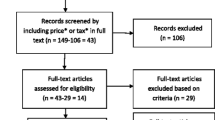Abstract
Binge drinking is associated with many health problems, including unintentional injuries, intentional injuries (e.g., domestic violence, sexual assault), unintended pregnancy, and liver disease. Moreover, high-volume episodic binge drinking is very prevalent among teenagers and young adults. Given that approximately 90 % of the alcohol consumed by youth under the age of 21 in the USA is in the form of binge drinking (Murphy et al. in Addict Res Theory 20(6):456–465, 2012), understanding the determinants of binge drinking behavior, particularly among youth, is important from the perspective of health and policy. In this paper, we explore the relationship between youth binge drinking and an unanticipated determinate of this behavior, minimum wage laws. Using a fixed effects regression model, we observe a positive relationship between minimum wage increases and binge drinking among teenagers. We find that, after accounting for demographic characteristics, different types of risky behaviors, excise tax, state and time fixed effects, and time-varying state effects, a $1 increase in minimum wage increases binge drinking among teenagers by approximately 9 %. Our results support recent findings that minimum wage increases are positively associated with alcohol-related accidents among teenagers (Adam et al. in Rev Econ Stat 94(3):828–840, 2012). Findings suggest that authorities should consider the unexpected impacts that minimum wage increase may have on alcohol consumption among teens and consider parallel policies to help mitigate potential negative consequences.
Similar content being viewed by others
Notes
YBRS provides a repeated cross section of teens from different states over time, and it does not provide repeated information on the same teens.
Allison and Waterman (2002) demonstrate that a conditional likelihood method for negative binomial regression does not qualify as a true fixed effects method because it does not control for unchanging covariates, and hence, an unconditional estimation of a fixed effects negative binomial model is needed.
In all cases, the test statistic is large and negative. These findings suggest that the zero-inflated model is indistinguishable from the nonzero-inflated analog, indicating that excess zeros are not likely generated by a separate process from the count values.
Results are robust to using a zero-inflated negative binominal approach, with participant age and smoking habits used as the inflators. See Appendix 2.
Results are robust to excluding 1991 from the sample.
References
Adams S, Blackburn LMK, Cotti DC (2012) Minimum wages and alcohol-related traffic fatalities among teens. Rev Econ Stat 94(3):828–840
Addison TJ, Blackburn LMK, Cotti DC (2009) Do minimum wages raise employment? Evidence from the U.S. retail-trade sector. Labour Econ 16(4):397–408
Alexander Wagenaar C, Traci Toomey L (2002) Effects of minimum drinking age laws: review and analyses of the literature from 1960 to 2000. J Stud Alcohol 14:206–225
Allison DP, Waterman PR (2002) Fixed-effects negative binomial regression models. Sociol Methodol 32:247–265
Arellano M (1987) Computing robust standard errors for within-group estimators. Oxf Bull Econ Stat 49(4):0305–9049
Arkes J (2007) Does the economy affect teenage substance use? Health Econ 16(1):19–36
Bertrand M, Duflo E, Mullainathan S (2004) How much should we trust difference in differences estimates? Q J Econ 119(1):249–275
Card D (1992) Do minimum wages reduce employment? A case study of California 1987–1989. Ind Labor Relat Rev 46:22–37
Card D, Krueger BA (1994) Minimum wages and employment: A case study of the fast-food industry in New Jersey and Pennsylvania. Am Econ Rev 84:772–793
Centers for Disease and Control Prevention (2012) Teen drinking and driving—a dangerous mix: http://www.cdc.gov/vitalsigns/TeenDrinkingAndDriving/index.html
Centers for Disease Control and Prevention (2012) Web-based injury statistics query and reporting system. http://www.cdc.gov/motorvehiclesafety/teen_drivers/teendrivers_factsheet.html
Centers for Disease Control and Prevention (2014) Fact sheets—binge drinking: http://www.cdc.gov/alcohol/fact-sheets/binge-drinking.htm
Current population study—ORG: http://www.nber.org/data/morg.html
Current population study – ORG: http://www.nber.org/data/morg.html
Dube A, Lester TW, Reich M (2010) Minimum wage effects across state borders: estimates using contiguous counties. Revf Econ Stat 92(4):945–964
Hausman J, Hall HB, Griliches Z (1984) Econometric models for count data with applications to the patents R and D relationship. Econometrica 52:909–938
Hingson R, Heeren T, Winter M (2000) Effects of recent 0.08 % legal blood alcohol limits on fatal crash involvement. Injury Prev 6:109–114
Markowitz S, Tauras J (2009) Substance use among adolescent students with consideration of budget constraints. Rev Econ Household 7(4):423–446
Murphy GJ et al (2012) A behavioral economic supplement to brief motivational interventions for college drinking. Addict Res Theory 20(6):456–465
Naimi TS et al (2003) Binge drinking among U.S. adults. J Am Med Assoc 289(1):70–75
National Center on Addiction and Substance Abuse (2003) National survey of American attitudes on substance abuse VIII: Teens and parents. Columbia University, New York
Neumark D, Wascher LW (2008) Minimum wages. The MIT Press, Cambridge, MA
Nolen Hoeksema S (2004) Gender differences in risk factors and consequences for alcohol use and problems. Clin Psychol Rev 24:981
Office of Juvenile Justice and Delinquency Prevention (OJJDP) (2005) Drinking in America: myths, realities, and prevention policy. Department of Justice, Office of Justice Programs, Office of Juvenile Justice and Delinquency Prevention, Washington, DC
Ruhm JC (1996) Alcohol policies and highway vehicle fatalities. J Health Econ 15(4):435–454
The National Institute on Alcohol Abuse and Alcoholism. http://www.niaaa.nih.gov/alcohol-health/overview-alcohol-consumption/moderate-binge-drinking
Vuong HQ (1989) Likelihood ratio rests for model selection and non-nested hypotheses. Econometrica 57(2):307–333
Wagenaar AC, Toomey LT (2002) Effects of minimum drinking age laws: review and analyses of the literature from 1960 to 2000. J Stud Alcohol Suppl 14:206–225
Author information
Authors and Affiliations
Corresponding author
Appendices
Appendix 1
See Table 6.
Appendix 2
See Table 7.
Appendix 3
See Table 8.
Rights and permissions
About this article
Cite this article
Hoke, O., Cotti, C. Minimum wages and youth binge drinking. Empir Econ 51, 363–381 (2016). https://doi.org/10.1007/s00181-015-0998-8
Received:
Accepted:
Published:
Issue Date:
DOI: https://doi.org/10.1007/s00181-015-0998-8




